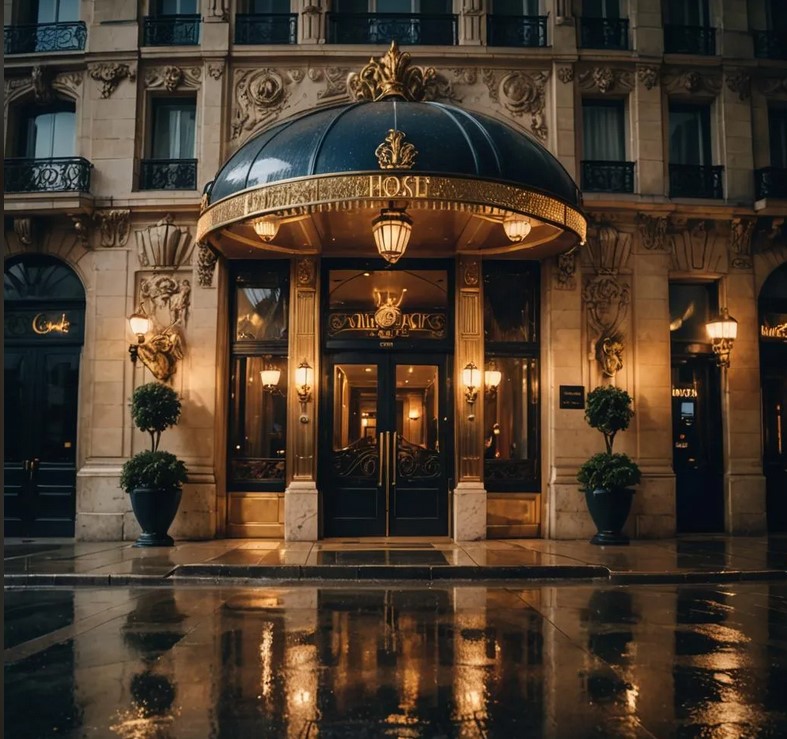Hôtel Lutetia: Difference between revisions
No edit summary |
No edit summary |
||
| (One intermediate revision by the same user not shown) | |||
| Line 1: | Line 1: | ||
;[[Paris]] -P- [[Paris - La Belle Époque]] | ;[[Paris]] -P- [[Paris - La Belle Époque]] | ||
[[]] | [[File:Hotel Lutecia.jpg]] | ||
Opened 1904, in September. | Opened 1904, in September. | ||
<br> | <br> | ||
<br> | <br> | ||
The Hôtel Lutetia, located at 45 Boulevard Raspail, in the Saint-Germain-des-Prés area of the 6th arrondissement of Paris, is one of the best-known hotels on the Left Bank. It is noted for its architecture and its historical role during the German occupation of France in World War II. | |||
==History== | |||
==Early years== | |||
The Lutetia was built in 1910 in the Art Nouveau style to designs by architects Louis-Charles Boileau and Henri Tauzin. It was founded by the Bon Marché department store, which sits opposite it facing Square Boucicaut. The Lutetia is located at the intersection of Boulevard Raspail and rue de Sèvres, adjacent to the Sèvres-Babylone Métro station. The hotel is named for an early pre-Roman town that existed where Paris is now located. | |||
Famous guests over the years have included Pablo Picasso, Charles de Gaulle, Marianne Oswald, André Gide, Peggy Guggenheim and Josephine Baker. James Joyce wrote part of Ulysses at the hotel. Dawn Powell lived at the Lutetia for three months in the fall of 1950, during her only visit to Europe. | |||
==World War II== | |||
In the late 1930s, the Lutetia was a frequent gathering place for anti-Nazi German exiles, among them Heinrich Mann, Willi Mutzner and the young Willy Brandt. In the Nazi regime's propaganda of the time, these exiles were disparagingly called "The Lutetia Crowd". | |||
The war began in September 1939, and numerous refugees fled to Paris from conflict areas and places occupied by German forces. The Lutetia attempted to accommodate as many as possible. Because of its reputation, it was filled with a number of displaced artists and musicians. However, the French government evacuated Paris beginning June 14, 1940 and the Germans entered and occupied the city. A number of the Lutetia's residents escaped; others were captured by the Germans. The hotel itself was requisitioned by the Abwehr (counter-espionage), and used to house, feed, and entertain German officers such as Alfred Toepfer and the French collaborator Rudy de Mérode. | |||
When Paris was liberated in August 1944, the hotel was abandoned by German troops and taken over by French and American forces. From then until after the end of the war, it was used as a repatriation center for prisoners of war, displaced persons, and returnees from German concentration camps. | |||
Latest revision as of 18:11, 3 November 2024
Opened 1904, in September.
The Hôtel Lutetia, located at 45 Boulevard Raspail, in the Saint-Germain-des-Prés area of the 6th arrondissement of Paris, is one of the best-known hotels on the Left Bank. It is noted for its architecture and its historical role during the German occupation of France in World War II.
History
Early years
The Lutetia was built in 1910 in the Art Nouveau style to designs by architects Louis-Charles Boileau and Henri Tauzin. It was founded by the Bon Marché department store, which sits opposite it facing Square Boucicaut. The Lutetia is located at the intersection of Boulevard Raspail and rue de Sèvres, adjacent to the Sèvres-Babylone Métro station. The hotel is named for an early pre-Roman town that existed where Paris is now located.
Famous guests over the years have included Pablo Picasso, Charles de Gaulle, Marianne Oswald, André Gide, Peggy Guggenheim and Josephine Baker. James Joyce wrote part of Ulysses at the hotel. Dawn Powell lived at the Lutetia for three months in the fall of 1950, during her only visit to Europe.
World War II
In the late 1930s, the Lutetia was a frequent gathering place for anti-Nazi German exiles, among them Heinrich Mann, Willi Mutzner and the young Willy Brandt. In the Nazi regime's propaganda of the time, these exiles were disparagingly called "The Lutetia Crowd".
The war began in September 1939, and numerous refugees fled to Paris from conflict areas and places occupied by German forces. The Lutetia attempted to accommodate as many as possible. Because of its reputation, it was filled with a number of displaced artists and musicians. However, the French government evacuated Paris beginning June 14, 1940 and the Germans entered and occupied the city. A number of the Lutetia's residents escaped; others were captured by the Germans. The hotel itself was requisitioned by the Abwehr (counter-espionage), and used to house, feed, and entertain German officers such as Alfred Toepfer and the French collaborator Rudy de Mérode.
When Paris was liberated in August 1944, the hotel was abandoned by German troops and taken over by French and American forces. From then until after the end of the war, it was used as a repatriation center for prisoners of war, displaced persons, and returnees from German concentration camps.
